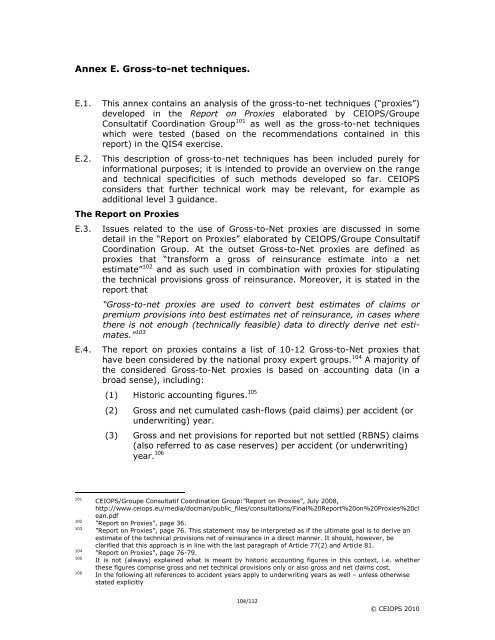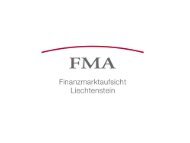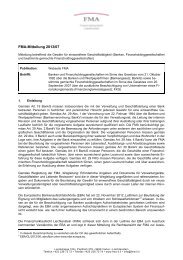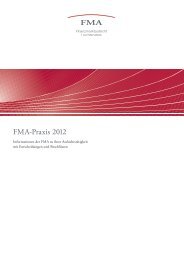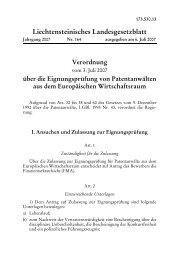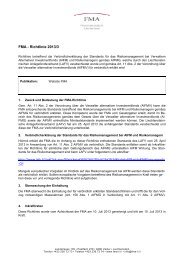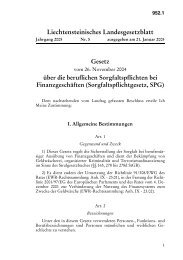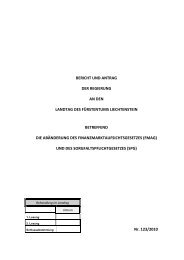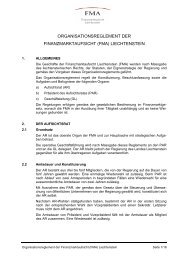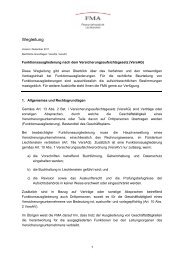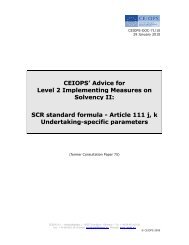CEIOPS' Advice for Level 2 Implementing ... - EIOPA - Europa
CEIOPS' Advice for Level 2 Implementing ... - EIOPA - Europa
CEIOPS' Advice for Level 2 Implementing ... - EIOPA - Europa
Create successful ePaper yourself
Turn your PDF publications into a flip-book with our unique Google optimized e-Paper software.
Annex E. Gross-to-net techniques.<br />
E.1. This annex contains an analysis of the gross-to-net techniques (“proxies”)<br />
developed in the Report on Proxies elaborated by CEIOPS/Groupe<br />
Consultatif Coordination Group 101 as well as the gross-to-net techniques<br />
which were tested (based on the recommendations contained in this<br />
report) in the QIS4 exercise.<br />
E.2. This description of gross-to-net techniques has been included purely <strong>for</strong><br />
in<strong>for</strong>mational purposes; it is intended to provide an overview on the range<br />
and technical specificities of such methods developed so far. CEIOPS<br />
considers that further technical work may be relevant, <strong>for</strong> example as<br />
additional level 3 guidance.<br />
The Report on Proxies<br />
E.3. Issues related to the use of Gross-to-Net proxies are discussed in some<br />
detail in the “Report on Proxies” elaborated by CEIOPS/Groupe Consultatif<br />
Coordination Group. At the outset Gross-to-Net proxies are defined as<br />
proxies that “trans<strong>for</strong>m a gross of reinsurance estimate into a net<br />
estimate” 102 and as such used in combination with proxies <strong>for</strong> stipulating<br />
the technical provisions gross of reinsurance. Moreover, it is stated in the<br />
report that<br />
“Gross-to-net proxies are used to convert best estimates of claims or<br />
premium provisions into best estimates net of reinsurance, in cases where<br />
there is not enough (technically feasible) data to directly derive net estimates.”<br />
103<br />
E.4. The report on proxies contains a list of 10-12 Gross-to-Net proxies that<br />
have been considered by the national proxy expert groups. 104 A majority of<br />
the considered Gross-to-Net proxies is based on accounting data (in a<br />
broad sense), including:<br />
(1) Historic accounting figures. 105<br />
(2) Gross and net cumulated cash-flows (paid claims) per accident (or<br />
underwriting) year.<br />
(3) Gross and net provisions <strong>for</strong> reported but not settled (RBNS) claims<br />
(also referred to as case reserves) per accident (or underwriting)<br />
year. 106<br />
101 CEIOPS/Groupe Consultatif Coordination Group:”Report on Proxies”, July 2008,<br />
http://www.ceiops.eu/media/docman/public_files/consultations/Final%20Report%20on%20Proxies%20cl<br />
ean.pdf<br />
102 ”Report on Proxies”, page 36.<br />
103 ”Report on Proxies”, page 76. This statement may be interpreted as if the ultimate goal is to derive an<br />
estimate of the technical provisions net of reinsurance in a direct manner. It should, however, be<br />
clarified that this approach is in line with the last paragraph of Article 77(2) and Article 81.<br />
104 ”Report on Proxies”, page 76-79.<br />
105 It is not (always) explained what is meant by historic accounting figures in this context, i.e. whether<br />
these figures comprise gross and net technical provisions only or also gross and net claims cost.<br />
106 In the following all references to accident years apply to underwriting years as well – unless otherwise<br />
stated explicitly<br />
104/112<br />
© CEIOPS 2010


